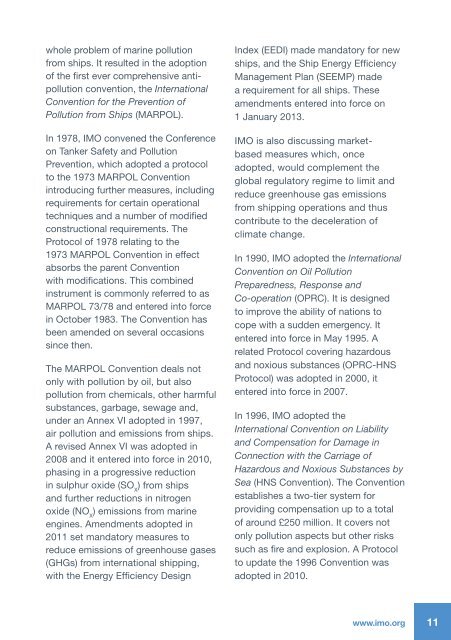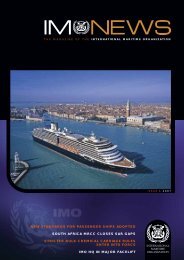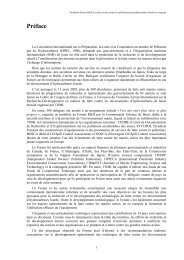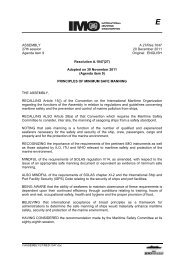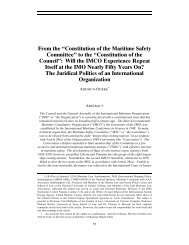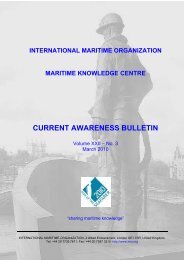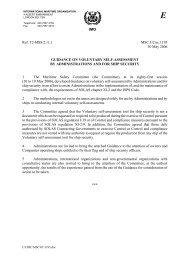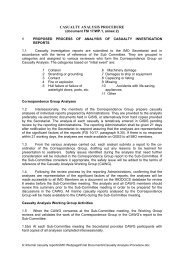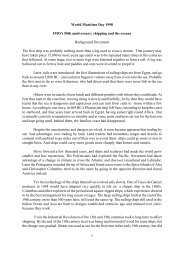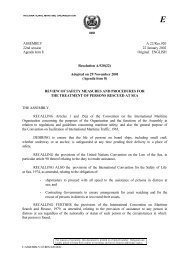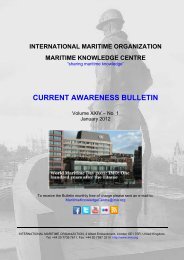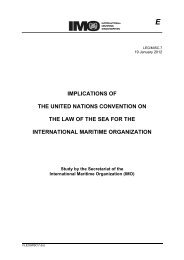What it is - International Maritime Organization
What it is - International Maritime Organization
What it is - International Maritime Organization
You also want an ePaper? Increase the reach of your titles
YUMPU automatically turns print PDFs into web optimized ePapers that Google loves.
whole problem of marine pollution<br />
from ships. It resulted in the adoption<br />
of the first ever comprehensive antipollution<br />
convention, the <strong>International</strong><br />
Convention for the Prevention of<br />
Pollution from Ships (MARPOL).<br />
In 1978, IMO convened the Conference<br />
on Tanker Safety and Pollution<br />
Prevention, which adopted a protocol<br />
to the 1973 MARPOL Convention<br />
introducing further measures, including<br />
requirements for certain operational<br />
techniques and a number of modified<br />
constructional requirements. The<br />
Protocol of 1978 relating to the<br />
1973 MARPOL Convention in effect<br />
absorbs the parent Convention<br />
w<strong>it</strong>h modifications. Th<strong>is</strong> combined<br />
instrument <strong>is</strong> commonly referred to as<br />
MARPOL 73/78 and entered into force<br />
in October 1983. The Convention has<br />
been amended on several occasions<br />
since then.<br />
The MARPOL Convention deals not<br />
only w<strong>it</strong>h pollution by oil, but also<br />
pollution from chemicals, other harmful<br />
substances, garbage, sewage and,<br />
under an Annex VI adopted in 1997,<br />
air pollution and em<strong>is</strong>sions from ships.<br />
A rev<strong>is</strong>ed Annex VI was adopted in<br />
2008 and <strong>it</strong> entered into force in 2010,<br />
phasing in a progressive reduction<br />
in sulphur oxide (SO X<br />
) from ships<br />
and further reductions in n<strong>it</strong>rogen<br />
oxide (NO X<br />
) em<strong>is</strong>sions from marine<br />
engines. Amendments adopted in<br />
2011 set mandatory measures to<br />
reduce em<strong>is</strong>sions of greenhouse gases<br />
(GHGs) from international shipping,<br />
w<strong>it</strong>h the Energy Efficiency Design<br />
Index (EEDI) made mandatory for new<br />
ships, and the Ship Energy Efficiency<br />
Management Plan (SEEMP) made<br />
a requirement for all ships. These<br />
amendments entered into force on<br />
1 January 2013.<br />
IMO <strong>is</strong> also d<strong>is</strong>cussing marketbased<br />
measures which, once<br />
adopted, would complement the<br />
global regulatory regime to lim<strong>it</strong> and<br />
reduce greenhouse gas em<strong>is</strong>sions<br />
from shipping operations and thus<br />
contribute to the deceleration of<br />
climate change.<br />
In 1990, IMO adopted the <strong>International</strong><br />
Convention on Oil Pollution<br />
Preparedness, Response and<br />
Co-operation (OPRC). It <strong>is</strong> designed<br />
to improve the abil<strong>it</strong>y of nations to<br />
cope w<strong>it</strong>h a sudden emergency. It<br />
entered into force in May 1995. A<br />
related Protocol covering hazardous<br />
and noxious substances (OPRC-HNS<br />
Protocol) was adopted in 2000, <strong>it</strong><br />
entered into force in 2007.<br />
In 1996, IMO adopted the<br />
<strong>International</strong> Convention on Liabil<strong>it</strong>y<br />
and Compensation for Damage in<br />
Connection w<strong>it</strong>h the Carriage of<br />
Hazardous and Noxious Substances by<br />
Sea (HNS Convention). The Convention<br />
establ<strong>is</strong>hes a two-tier system for<br />
providing compensation up to a total<br />
of around £250 million. It covers not<br />
only pollution aspects but other r<strong>is</strong>ks<br />
such as fire and explosion. A Protocol<br />
to update the 1996 Convention was<br />
adopted in 2010.<br />
www.imo.org 11


